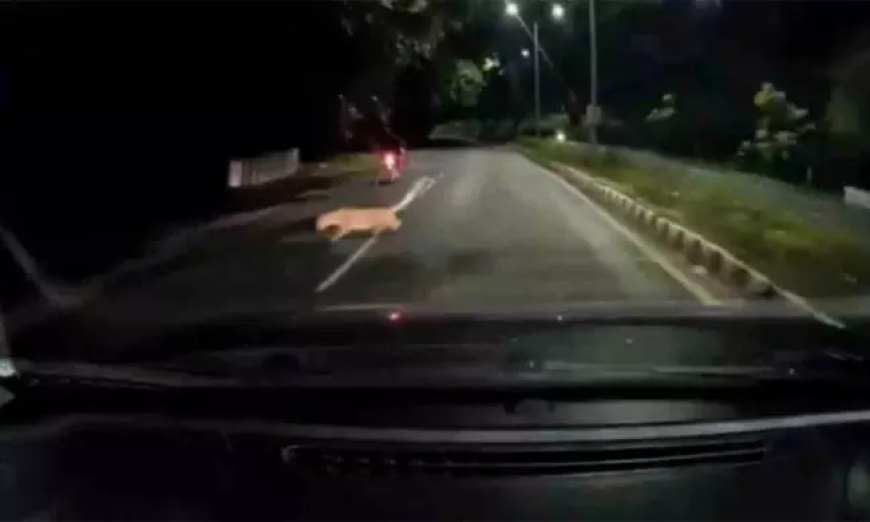Leopard Lunges at Bikers Near Tirupati: Dash-Cam Footage Sparks Alarming Debate on Human-Wildlife Conflict
A leopard was caught on dash-cam lunging at bikers near Tirupati, Andhra Pradesh. The video has gone viral, raising concerns about increasing human-wildlife conflicts in protected zones.

In a chilling reminder of the growing interface between human activity and wildlife territory, a viral dash-cam video from Tirupati has taken the internet by storm. The footage, recorded near Sri Venkateswara Wildlife Sanctuary, shows a leopard emerging from the forest edge and lunging toward a moving motorcycle, narrowly missing the riders.
The incident occurred late Sunday evening on the Tirupati–Kadapa State Highway, a route that passes through ecologically sensitive forest zones. The two riders, reportedly locals from Chittoor district, escaped unharmed. But the alarming close call has reignited national concern over India's escalating human-wildlife conflicts, especially in areas near protected reserves.
The Viral Incident: What We Know
The 45-second clip, captured via dash-cam by a car traveling behind the bike, shows the leopard crouched near roadside bushes. As the motorcycle approaches, the animal suddenly darts across the road, aiming straight for the bikers. In a narrow escape, the motorcycle swerves while the leopard halts mid-pursuit, vanishing into the undergrowth.
While no injuries were reported, the proximity of the attack to a public road has raised alarm among forest officials and conservationists alike.
“This is not a typical predator behaviour unless the animal is either disoriented, provoked, or has grown accustomed to human activity,” said Dr. Rajeev Menon, a wildlife ecologist with the Wildlife Institute of India.
The video has since been verified and circulated widely across social media and news platforms, with hashtags like #TirupatiLeopardAttack and #HumanWildlifeConflict trending on X and YouTube.
Location and Ecological Context
The Sri Venkateswara Wildlife Sanctuary, spread over 353 sq km across Tirupati and Kadapa districts, is home to several wild species including leopards, sloth bears, Indian wolves, and spotted deer. The region is also a pilgrimage hotspot due to its proximity to the Tirumala temple, leading to heavy vehicle movement through forest roads.
According to Andhra Pradesh Forest Department officials, wildlife movement across this corridor has increased in recent years due to deforestation, fragmented habitats, and a rise in road infrastructure near sanctuaries.
“We are witnessing more frequent leopard sightings near habitations. Camera trap data also indicates higher nocturnal activity along roadside forest belts,” said a senior Tirupati forest officer, requesting anonymity.
Why This Is Not an Isolated Event
India has recorded a sharp rise in human-wildlife encounters, especially involving big cats. According to the Ministry of Environment, Forest and Climate Change, over 200 human fatalities related to leopard or tiger conflicts were reported between 2021 and 2024.
Key contributing factors include:
-
Urban sprawl and infrastructure projects cutting through protected corridors
-
Encroachment and illegal settlements near forest zones
-
Scarcity of prey and shrinking buffer areas, driving animals closer to human habitations
-
Increased night travel on forest-adjacent highways
Wildlife Experts React
Wildlife experts have emphasized the urgent need for strict regulation of human activity near wildlife corridors.
“This leopard’s boldness reflects a broader behavioral shift. When animals lose fear of humans, the risk of attacks and retaliation increases,” warned Dr. Priya Narayanan, carnivore biologist and advisor to the National Tiger Conservation Authority.
Some have also questioned why speed limits and signages on forest roads continue to be widely ignored. Conservation NGOs working in Andhra Pradesh are calling for night-time travel bans on highways passing through core wildlife zones.
Authorities Respond
Following the incident, the Andhra Pradesh Forest Department has deployed additional patrolling units along the Tirupati–Kadapa highway stretch and installed temporary camera traps to monitor leopard activity.
Forest officials are also expected to launch a community outreach campaign in nearby villages like Chandragiri and Pakala, educating locals on how to respond to wildlife sightings.
A press note from the Forest Department stated:
“We urge travelers to avoid stopping in forest zones, use dim lights at night, and report any wildlife sightings through the toll-free helpline 1800-425-4545.”
High-Quality Reference Links (Backlinks)
To provide readers with credible sources and resources for further learning, here are authoritative links:
-
Wildlife Institute of India – Human-Wildlife Conflict Reports
Detailed research papers and guidelines on conflict mitigation. -
MoEFCC – National Wildlife Action Plan
India’s policy framework for managing wildlife and conservation zones. -
Andhra Pradesh Forest Department – Public Notices
Updates on patrol areas, leopard activity zones, and citizen advisories. -
National Tiger Conservation Authority (NTCA)
Learn more about India’s efforts to protect large carnivores and their habitats. -
TRAFFIC India – Wildlife Trade & Urban Pressures
Reports on illegal wildlife trade and its impact on species behaviour.
What Needs to Change
The shocking near-attack in Tirupati is a stark reminder that our growing footprint in forested areas cannot go unchecked. Experts call for:
-
Strict enforcement of road rules in eco-sensitive zones, including speed limits and honking bans.
-
Mandatory wildlife overpasses and underpasses in upcoming highway and rail projects.
-
Coexistence education for both urban and rural communities near forests.
-
Strengthening of prey base and buffer zones to discourage big cats from straying.
-
Better compensation frameworks to reduce retaliatory killings after conflicts.
“The solution lies in coexistence, not in fencing off forests or killing wildlife. If we infringe on their space, the least we can do is respect their boundaries,” said Dr. Nandini Iyer, a human-wildlife conflict mitigation strategist with WWF India.
Conclusion
The leopard encounter near Tirupati has understandably rattled citizens. But it must also serve as a wake-up call. As India’s infrastructure expands, the lines between the natural and human world are blurring, and the consequences are becoming harder to ignore.
The challenge now is not just saving wildlife, but protecting people and animals from one another, through responsible planning, stronger laws, and public awareness.



















































